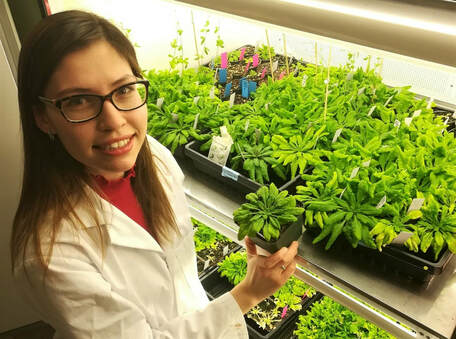|
Kristen Siegel, MSc Candidate, Dept Biology, Queen's University, Monaghan Lab
Stomata are microscopic pores found in leaf epidermal tissue that facilitate gas exchange between a plant and its environment during photosynthesis. Each pore is bordered with two specialized guard cells, which can modulate their turgidity to cause stomatal opening or closure. Photosynthetically favourable conditions, such as high levels of blue light, induce stomatal opening through guard cell water uptake. However, these openings are also commonly seized as a point of entry for plant microbial pathogens. Upon pathogen detection, plasma membrane-localized receptors will initiate intracellular signalling cascades, and ultimately cause stomatal closure though water efflux and guard cell deflation. This process, known as stomatal defense, contributes to a broad-spectrum immune response which is sufficient to defend against most pathogens. In a proteomics-based screen for regulators of immunity in Arabidopsis thaliana, we identified components of stomatal defense as well as several proteins with unknown function. Of particular interest was a novel protein belonging to a small family of mitogen-activated protein kinases involved in blue-light induced stomatal opening. This work investigates the putative role of this family in stomatal defense and immune signalling. Irina Sementchoukova, MSc candidate, Monaghan Lab, Dept Biology, Queen's
Pseudomonas syringae is a bacterial pathogen that causes disease in a broad range of plant species. As a part of its infection strategy, P. syringae releases virulence factors called effectors into plant cells to disarm host defenses. In response to effector sabotage, plants evolved intracellular NUCLEOTIDE BINDING AND LEUCINE RICH REPEAT RECEPTORS (NLRs) that ‘guard’ the integrity of critical immune signalling components prone to be effector targets. When no damage is detected, NLRs remain in the ‘OFF’ state, and only turn ‘ON’ when perturbations are detected in the guarded protein. Activated NLRs typically result in a form of programmed cell death at the site of infection that protects surrounding uninfected tissues. MEMBRANE ATTACK COMPLEX/PERFORIN (MACPF) proteins are well known agents of defense in the mammalian immune system, though the molecular function of this protein family in plants has not been established. The model plant Arabidopsis thaliana encodes four MACPF domain proteins, and genetic evidence suggests that at least two of these proteins are involved in the plant immune response. Interestingly, loss-of-function mutations in these loci result in hyperactive immune signaling and cell death, reminiscent of dysregulated NLR activation. My project has thus been focused on determining if MACPF proteins may be effector targets guarded by plant NLRs. |
Archives
February 2021
|


